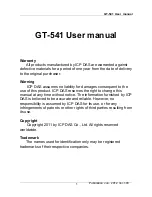
EW50 Industrial LTE Cellular Gateway
86
2.5 Routing
If you have more than one router and subnet, you will need to enable routing in order to allow packets to find
a proper routing path and allow different subnets to communicate with each other. Routing is the process of
selecting best paths in a network. It is performed for many kinds of networks, like electronic data networks
(such as the Internet), by using packet switching technology. The routing process usually directs forwarding on
the basis of routing tables which maintain a record of the routes to various network destinations. Thus,
constructing routing tables, which are held in the router's memory, is very important for efficient routing. Most
routing algorithms use only one network path at a time.
The routing tables can contain pre-defined routing paths for specific destinations. This is
static routing
.
However, if the contents of routing tables record the obtained routing paths from neighbor routers by using
protocols such as RIP, OSPF and BGP, this is
dynamic routing
. Both routing approaches will be illustrated. In
addition, the gateway has advanced configurable routing software
Quagga built-in for more complex routing
applications. It can be configured via Telnet CLI.
















































